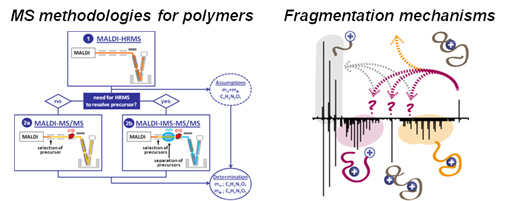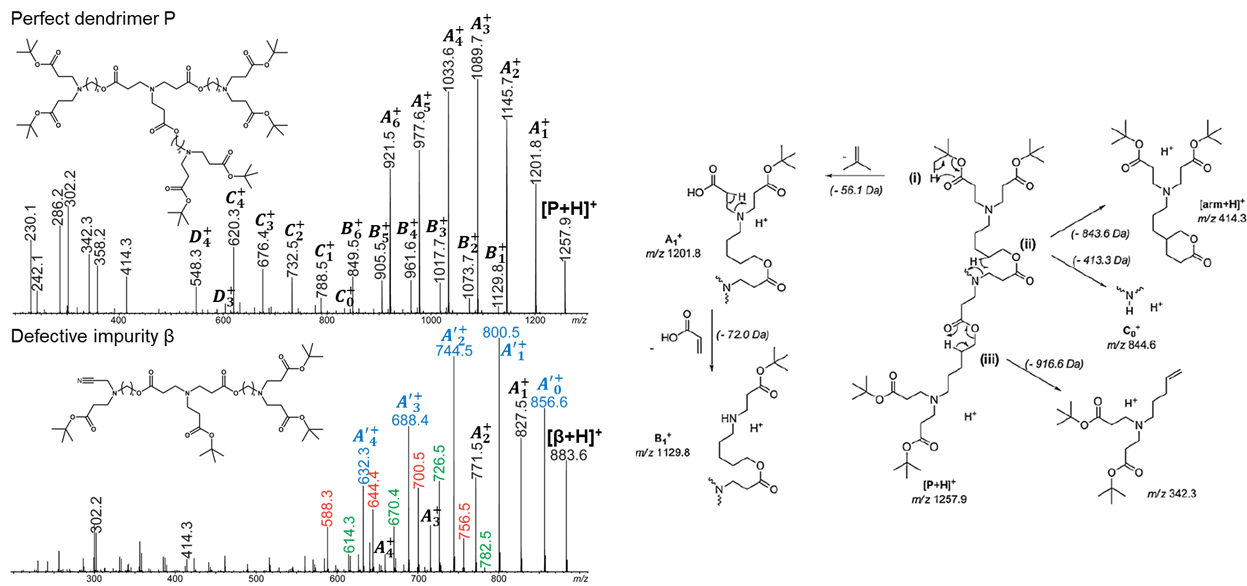Research Overview

Structural characterization of synthetic polymers
Macroscopic properties of synthetic polymers rely on molecular parameters such as size, chemical composition, end-groups and architecture. Our group develops analytical methodologies based on mass spectrometry for precise characterization of these parameters. A particular attention is focused on the influence of polydispersity and end-group reactivity during the ionization step. We also study fragmentation mechanisms of new polymers in order to establish dissociation rules used to characterize their end-groups.
Structural characterization of dendrimers
Dendrimers are a class of synthetic polymers with a highly ramified symmetrical structure. Their surface can be functionalized to complex a great variety of ligands to be delivered at the cellular level. Due to their potential applications in numerous medical areas, dendrimer samples must be scrutinized for any structural defects. Sensitivity is a major advantage of MS to detect such impurities often present at trace levels.


MS/MS sequencing of digital polymers
Similar to storage of genetic information in DNA based on controlled sequences of four nucleotides, a string of binary information can be implemented in a synthetic polymer using co-monomers intentionally defined as letters of an alphabet. This class of synthetic macromolecules was recently identified as a potential new breakthrough in polymer science. On the one hand, “writing” information in a polymer requires synthetic approaches specifically developed for the production of strictly monodisperse chains, which has been achieved by the pioneer group of Dr Jean-François Lutz at the Institut Charles Sadron in Strasbourg (France) using solid-phase iterative methodologies involving chemoselective steps. On the other hand, the “reading” step allowing access to molecular information stored in such copolymers is typically a sequencing task for which tandem mass spectrometry (MS/MS) has long proved its efficiency and reliability. However, mass spectrometry happened to be far more than a “simple” characterization technique for this class of macromolecules. Indeed, unlike biopolymers such as peptides or oligosaccharides obeying universal dissociation rules that allow their automated sequencing from MS/MS spectra, fragmentation patterns of synthetic species strongly depend on the chemistry of polymer backbone. Yet, in contrast to biopolymer sequencing where molecular structures imposed by biology dictate the read-out rules, synthetic macromolecules can be tailored to address specific requirements regarding their dissociation upon collisional activation. In other word, MS/MS design of encoded polymers becomes a new paradigm for the development of information-storing macromolecules. This approach enables full sequence coverage for reliable reading of information encoded in the backbone of digital polymers developed either for massive data storage or in anticounterfeiting applications.
Ion mobility spectrometry of synthetic polymers
MS has become an essential technique in polymer science, but increasingly complex samples produced to provide desirable macroscopic properties of high performance materials often require separation of species prior to their mass analysis. Similar to liquid chromatography, the IMS dimension introduces shape selectivity but enables separation at a much faster rate (milliseconds vs minutes). As a post-ionization technique, IMS can be hyphenated to MS to perform a double separation dimension of gas-phase ions, first as a function on their mobility (determined by their charge state and collision cross section, CCS) then as a function of their m/z ratio. Such coupling permits to reduce spectral complexity, to enhance the dynamic range of detection or to achieve separation of isobaric ions prior to their activation in MS/MS experiments. Coupling IMS to MS also provides valuable information regarding the 3D structure of polymer ions in the gas phase and to address the question of how charges are distributed within the structure.
